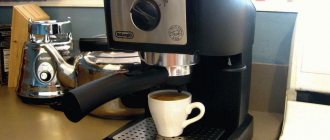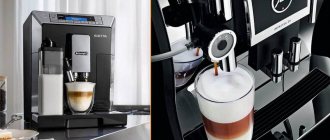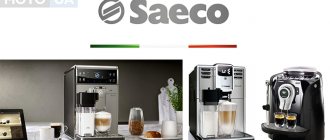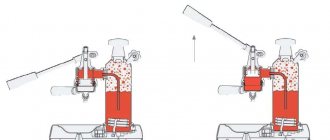Centuries passed, and the popularity of coffee only increased. It was successfully brewed in the royal chambers, khan's palaces and in the neighborhoods of the poor. To prepare an invigorating drink, masters successfully used:
- Openwork French coffee pots;
-Turkish cezves;
-Ordinary metal buckets.
Despite the huge variety of recipes, the essence of the process remained the same - cooking took place over an open fire or heated sand. The history of the modern coffee machine is as follows:
Operating principle of coffee machines
Coffee machines facilitate the process of preparing an aromatic drink and make it possible to regulate its strength, richness, as well as the structure of the foam, its size and many other parameters. Modern coffee makers are quite compact for home use and quite large for use in crowded places. Now there are many varieties of these devices, but the principle of operation is approximately the same for all: water is heated in a special tank, which passes through a filter with coffee, where it extracts all its substances, saturating the drink with taste and aroma.
Depending on the specific model, the process of heating water and preparing coffee may vary significantly. However, the scheme and sequence are common to all, and it consists of the following stages.
- Water is poured into a special tank. It can be heated all at once or in portions.
- Ground coffee is poured into the filter. It can be in the form of a powder or in a capsule (a special plastic disposable container designed for 1 serving). There are models with a built-in coffee grinder, so the raw materials are poured there in beans.
- Using a heating element, the water is brought to a certain temperature and directed into the compartment with ground grains. The brewing process itself occurs when steam-water liquid seeps through a filter with coffee into the flask. The result is a drink with a pleasant taste, rich color and invigorating aroma.
Main characteristics
The maximum pressure that these types of coffee machines have is only 3.3 bar. Of course, some might say that this is not enough to make delicious coffee. But that's not true. After all, special capsules are made for the BOSCH Tassimo coffee machine that contain unpressed coffee. Therefore, a lot of pressure is not required to prepare the drink. Water enters the capsule through a very thin nozzle. Due to this, the fluid supply speed increases.
An instantaneous water heater is another feature of coffee machines from this manufacturer. In this case, the device heats only the amount of water that is necessary to prepare the drink. The information is read from the barcode on the T-disk. Water is supplied by a special pump, passing it through a flow meter. After this, the liquid ends up in the thermostat. Here its temperature and how much more it needs to be heated are determined. After this, water is supplied to the second thermostat. Here it is heated to the required temperature. The water then passes through the T-disc to the coffee and into the cup.
Device
Based on the principle of operation common to all coffee machines, we can describe their structure:
- Water container.
- Ten. It is located in a reservoir of water or is a separate thermoblock with a spiral structure, but then a pressure (compression) pump is used to pump the liquid, and a safety valve is used to regulate the pressure.
- Coffee filter. Located at the outlet of the entire cooking system. This is where the drink is extracted.
- Flask with ready-made coffee. It comes in plastic, glass or just a ceramic mug.
Despite the fact that the principle of brewing (extracting) coffee is the same, coffee machines can differ greatly not only in structure and components, but also in functionality.
Healthy! Modern models are equipped with additional functions and operate according to specified characteristics. They can prepare a whole range of coffee drinks, including those with the addition of milk, cream, sugar, chocolate (for example, cappuccino, macchiato, latte, breve, mocha, marocino, etc.).
For greater user convenience, modern coffee machines are equipped with the following additional functions:
- choice of coffee strength;
- the ability to regulate the amount of water for one serving;
- built-in coffee grinder with grinding degree control;
- automatic cappuccino maker (whips milk into foam);
- self-cleaning of scale and sediment;
- setting the time to start work (delayed start) and others.
The above functionality is present in automatic models of coffee machines, such as Krups type xp 7240 or Saeco. Making coffee in them allows you to control and set parameters at each stage of work. And for those who don’t like to delve into the process, there are coffee makers where you just press one button and get a hot drink in a couple of minutes. These include: Delonghi drip coffee maker or Bosch capsule coffee machine.
Coffee machine Krups type xp 7240
Which is the best bean coffee maker for home: basic selection parameters
When choosing the optimal model, the buyer should first decide on the basic parameters that play an important role in operation and ease of use.
Dimensions and performance
For the owner of a large country house, the issue of the size of the purchased device is not relevant. But for people living in a small apartment, where the kitchen area is from 7 to 10 m2, this criterion sometimes becomes decisive. Therefore, if you want to save as much usable space as possible, we can recommend taking a closer look at the Jura Ena Micro 1 model, which is considered one of the smallest coffee machines for bean coffee in the world. Its parameters: width – 23 cm, depth – 32.3 cm, height – 44.5 cm.
Jura Ena Micro 1 is one of the most compact coffee machines for grain coffee. This is a full-fledged coffee maker that has a built-in grinder for coffee beans with a capacity of 125 grams, allows you to prepare up to 2 cups at a time and has an informative display. The cost is 37,890 rubles.
Review of Jura Ena Micro 1 More details on Yandex.Market: https://market.yandex.ru/product—kofemashina-jura-ena-micro-1/8443402/reviews?track=tabs
Jura Ena Micro 1
You should also consider performance when choosing. If it is expected that two people will drink coffee throughout the day, then the optimal models will be those designed to prepare up to 30 servings and not very expensive. Otherwise, you will need to take a closer look at more powerful devices.
Functionality
At this point, for grain coffee machines, the first place is the materials used to make the mill knives. They can be made of ceramic or steel. The first type works almost silently; there is also an opinion that ceramic knives do not burn the grains when grinding.
If you need to prepare more than one serving, it is better to choose machines that have the function of simultaneously brewing two cups
FOR YOUR INFORMATION!
The main disadvantage of ceramics is their high fragility. If a foreign object gets in, the knives become damaged and require replacement.
Millstones made of steel are more durable and practical, but create more noise during operation. Some models of coffee machines from leading manufacturers are equipped with a sound absorption system. The heating system also falls under the definition of functionality. It can be boiler type or in the form of a thermoblock. In the first case, water is collected into a container, and as it is depleted, a new supply and heating occurs. When using a thermoblock, a flow scheme is implemented to achieve the required water temperature.
Metal mill knives are more durable, but make more noise when grinding. The next parameter in the category of functionality can be considered the variability of drink preparation. Typically, budget models are equipped with only one recipe – espresso. If you have a cappuccino maker, you can prepare coffee with milk foam.
FOR YOUR INFORMATION!
The largest range of ready-made drinks is offered by capsule-type coffee machines, which is explained by the ability to place all the necessary components inside a sealed unit.
Another important detail when deciding which bean coffee machine to choose for your home, according to reviews, is the quality of grinding of the beans. There are models on the market where there is a function for adjusting the degree of grinding, which allows you to expand the range of ready-made drinks.
The presence of a cappuccino maker allows you to prepare coffee with thick foam
Additional options
In addition to the basic parameters, there are many additional functions that are aimed at increasing the comfort and ease of use of the device. Their presence is not mandatory. It should also be borne in mind that any addition affects the cost. Optional but useful options are:
- temperature control system, which allows you to obtain a high-quality finished drink, since coffee is very sensitive to the temperature of preparation;
- automatic cleaning. The machine automatically performs cleaning, for which the user only needs to throw a special tablet inside;
- built-in dispenser for preparing various volumes;
- cup heating system;
- built-in counter for prepared coffee portions;
- E-Plus system. This is an option that allows you to adjust the strength of the drink by changing the water pressure.
The larger and more expensive the car, the more additional options are built into it
Types of coffee machines based on operating principle
To understand how different models of coffee machines work and on what principle they work, you should understand the existing varieties and their differences. Despite the fact that the coffee extraction process is common, the approaches to its implementation in coffee machines are different. It all depends on the technologies and capabilities used.
Capsule
This type of device is the most ergonomic, simple, but at the same time more expensive. Capsule machines are designed for office or home use, as the output is one to two cups of coffee. Its operating principle is as follows. First, water is poured into a special tank, which is usually located at the back of the machine. Then a capsule containing ground compressed coffee in a sealed package (plastic and foil) is inserted into a special compartment. Next, water from the reservoir is supplied in portions to the thermoblock using a compression pump, where it is heated under high pressure. Then the liquid with a temperature of up to 95°C enters the compartment with the capsule, seeping through the punched hole, where it is brewed. The resulting drink passes through filters, in which all large and small particles of coffee settle, and flows into a flask or cup.
Advice! Among the manufacturers, the Italian company Nespresso, which specializes specifically in capsule-type coffee makers, has proven itself especially well.
Drip
The drip type model is simple and inexpensive, unlike others. It is good for preparing tasty and aromatic Americano. The main disadvantage is the cooking time (from 5 to 15 minutes). This is due to the fact that all the water is heated at once, and condensed steam is used to prepare coffee, which flows down the machine in droplets. The drink preparation process looks like this in more detail. First, cold water is poured into the tank, and ground coffee is poured into the filter. The liquid is then pumped into the boiler, where it is heated to boiling point. The resulting steam rises up the tube, where it is cooled to a given temperature (90°C), turning into condensate. Then the droplets flow into the filter with coffee, are saturated with it and are sent as a finished drink into the flask.
Important! In drip coffee makers, you should pay attention to power. The smaller it is, the stronger the coffee will be. The size of the flask is also important - the volume should be enough for 1-2 servings. If the container is too large, coffee will remain in it, which quickly cools down and loses its properties.
Geysernaya
In geyser coffee machines, water does not flow down while brewing, but rather rises up, like a geyser. Moreover, such a model can be electric or gas. In the latter case, water is heated using gas from a regular kitchen stove. The cooking process is simple. Cold water is poured into the lower compartment, then ground coffee is poured into the strainer, which is located between the lower and upper parts of the coffee maker. The water heats up and turns into steam, which puts pressure on the liquid, forcing it up the tube to the coffee strainer. There, the water is saturated with all the necessary extracts, and then enters the upper section, where the finished drink is directly accumulated.
Rozhkova
Such devices got their name thanks to a filter with a handle called a “horn” (holder). Ground coffee is placed in it, pre-pressed with a tamper to form a tablet (or pod). Another feature of this machine is that the drink is brewed not with hot water, but with steam, which passes through the tubes of the brewing group to the holder. The resulting condensate then flows into the mug.
Carob machines are most often used for mass preparation of coffee. However, this requires a person who will carry out all manipulations manually. In addition to their intended purpose, these coffee makers easily prepare cappuccino, all kinds of coffee drinks with milk and even tea. The carob model can also be equipped with an electric coffee grinder. This variety will be called Espresso.
Making cappuccino and latte
The Bosch Tassimo capsule coffee machine allows you to prepare not only espresso, but also other delicious drinks, such as latte or cappuccino. This takes much more time and requires human participation. After all, it is necessary to remove the milk T-disc and install the one containing the ground coffee.
It is worth noting that it is very difficult to prepare a latte at home - it is a labor-intensive process. The Bosch Tassimo coffee machine allows you to do this in just a few minutes. In this case, the volume of the cup must be at least 300 milliliters. The taste of the finished drink cannot be compared with what is sold in coffee shops.
Types of coffee machines by automation
Different types of coffee machines require manual labor to a greater or lesser extent to operate. Based on how automated the entire process is, we can distinguish these types of devices.
- Automatic. These models contain all the basic functions that are performed according to a predetermined program. The user just has to set the necessary parameters and supply the device with water, ground coffee (capsule or pod) and milk. In some models, all functions and modes are pre-programmed; you just need to select the type of coffee and press the start button. In other models, on the contrary, complete freedom of action is provided, where everyone is their own barista. Most coffee makers have a cappuccino maker that automatically prepares cappuccino, latte and mochaccino.
- Superautomatic machines. Such machines are designed for mass production of coffee. Superautomatic machines are purchased for cafes, restaurants, enterprises, and government agencies. To prepare a drink, you don’t need knowledge or skills, just press one button. Such machines are capable of preparing about 20 different types of coffee drinks with the addition of milk, sugar, cream and chocolate. It also provides bean grinding for preparing different types of coffee. Professional models can serve up to 200 people per hour.
- Semi-automatic machines Semi-automatic types of machines are distinguished by the fact that the number of functions in their arsenal is limited. They are equipped with minimal electronics and do not have the ability to dose coffee. In this regard, their advantage is their low price and ease of repair in case of failure. Such machines are used when you need to make regular coffee, or at most with milk. Complex recipes are not available to them.
- Manual There are no electronics in these devices; the cooking process depends entirely on manual labor. This type includes a carob or espresso coffee maker. The quality of the drink is determined manually during the preparation process. For example, the strength will depend on how tightly the ground coffee is pressed in the holder or on the amount of water per serving.
Coffee machine with beans for home: pros and cons
Like any household appliance, devices for making coffee from beans have their pros and cons. The main advantages can be considered:
- fully automated preparation of the drink;
- less waste, since constant refilling of coffee powder is not required;
- the use of grains allows you to get a fresh drink;
- savings on the purchase of raw materials;
- The presence of additional options allows you to adjust the taste of coffee.
The user of a grain coffee machine just needs to remember to add the beans, and then the device will do everything on its own. Despite the obvious advantages, coffee machines are not without some disadvantages, which are not important for most buyers:
- creating a certain noise during the grinding process;
- large dimensions when compared with a conventional coffee maker;
- higher cost;
- the need for regular internal cleaning.
Capsule coffee machines are cheaper than their carob counterparts, have smaller dimensions, but have their drawbacks, so the final choice is a subjective matter
Types of coffee machines according to the method of water supply
Coffee machines are also divided according to the method of water supply. This is relevant for making espresso, which many types of machines cannot handle.
Advice! Drip and geyser types can make “Americano”, but they cannot make “espresso”. For lovers of this drink, a carob model is suitable, which comes in two types: boiler and pump.
- Boiler room. The essence of its work is as follows: water is supplied at low pressure (up to 4 bar). Using a heating element, it is heated to a boil. The resulting steam interacts with ground coffee, resulting in a moderately bitter, medium-strength drink, not much different from an Americano. This is due to the fact that at low pressure, ground grains do not have time to convey all their rich taste and aroma to the steam-water liquid. Moreover, the boiling water itself has a detrimental effect on the quality of the resulting product.
- The pump coffee maker is designed in such a way that water passes through the brewing system under high pressure (up to 15 bar) without boiling (its temperature reaches 90-95°C). When passing through the holder, the hot liquid absorbs all the properties of coffee to the maximum. In addition, high-pressure steam produces a high and thick foam, which should occupy a quarter of the mug.
Interesting: strong, fragrant, but soft “espresso” is best prepared by a carob pump machine.
Making espresso
Repairing a Bosch coffee machine is a rather labor-intensive process. Therefore, you should use the device carefully. For example, to prepare espresso, you need to place a small cup on a special stand equipped with a drip tray. This allows you to place a container directly under the coffee dispenser. To remove the stand, you need to turn the special handle counterclockwise and the cup will rise up.
Now you can open the working compartment of the coffee machine, place the required capsule and close the device. There are usually only two buttons on the control panel: the small one turns the device on and off, and the large convex one starts the process. You need to press the last one. After this, the Bosch coffee machine will begin to read the barcode from the T-disk. Only after this will the preparation of the drink begin. This takes almost a minute. In this case, you do not need to stand near the device.
Terms of use
To make a high-quality drink and not spoil the device itself, you should carefully choose coffee and water.
- It is important to choose the optimal degree of grinding of coffee beans. Coarsely ground coffee will not be able to impart all its properties to hot water, so the taste will not be rich and may even become sour. Excessively fine grinding will make the drink too bitter and harm the device itself, clogging it.
- The water should not be hard. Otherwise, it will affect the taste of the drink. But the main thing is that sediment and scale can ruin the cooking system and lead to expensive repairs. You also need to monitor the water level in the container so that it does not fall below the minimum mark.
- You should regularly wash and clean all accessible compartments: the water container, the cooking system (oils and other impurities settle in it), the waste container, the cappuccino maker, the milk container and others. You can watch the video to see how to do this correctly. If necessary, special detergents are used in the form of tablets, which are placed in the compartments for ground coffee, and then the machine runs the entire cycle. If the machine has a self-cleaning function, it must be run periodically. It is important to prevent the occurrence of bacteria and fungi and extend the life cycle of the coffee machine.
Using coffee machines allows you to prepare everyone’s favorite aromatic drink simply, affordably and quickly. This has long been appreciated not only by gourmets, but also by amateurs. Some models provide everything for different occasions. Others allow you to get a single type of coffee with the press of just one button. Which coffee machine to choose is a matter of taste and capabilities of everyone.











